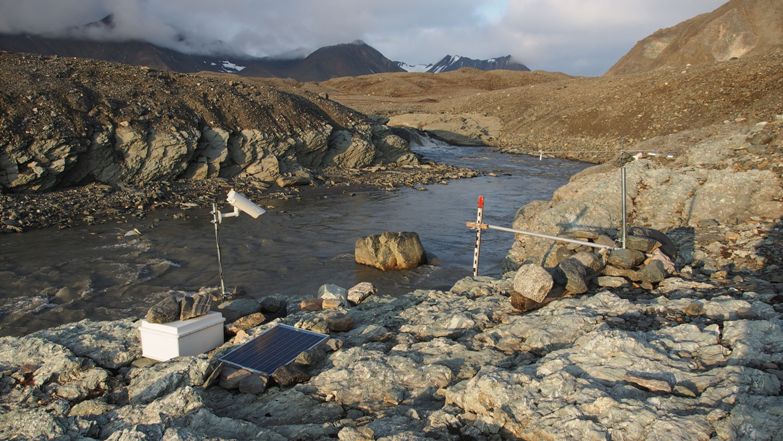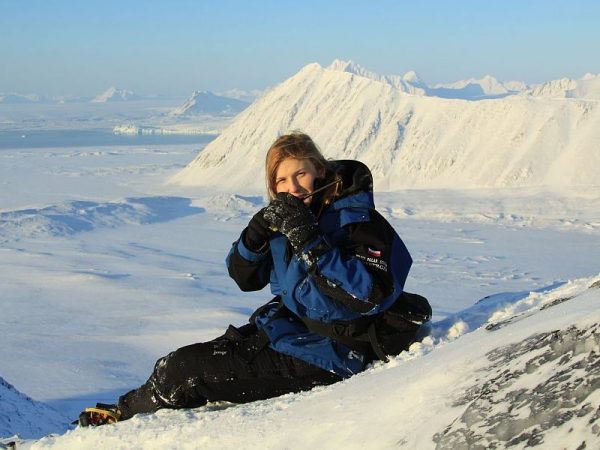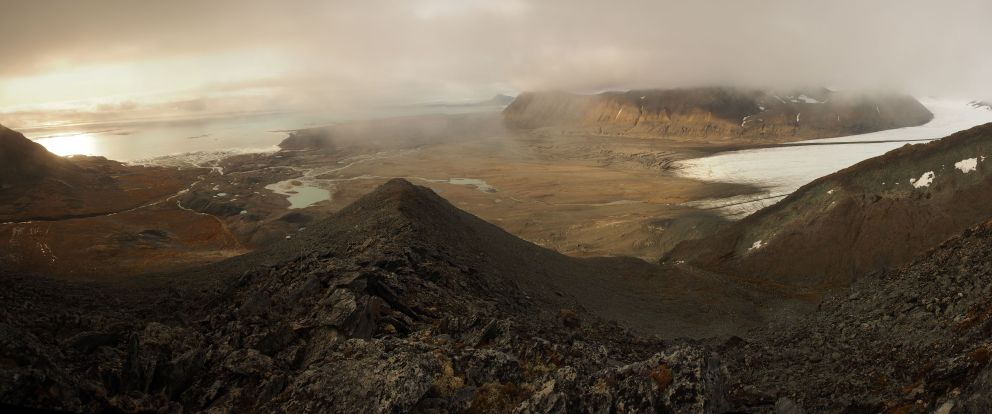In June 2020, another polar expedition under the “Hindcasting and projections of hydro-climatic conditions of Southern Spitsbergen” project was organised.
Due to the coronavirus pandemic, the expedition was held online thanks to the support of SIOS (Svalbard Integrated Arctic Earth Observing System) and UNIS (the University Centre in Svalbard).
Elżbieta Łepkowska, PhD Eng., from the Faculty of Natural Sciences of the University of Silesia, who is involved in the project implementation, talks about the expedition course and the importance of arctic research from the point of view of climate change.
Elżbieta Łepkowska, PhD Eng., during one of the Spitsbergen polar expedition | Photo by Katarzyna Cichała-Kamrowska
 |
The University of Silesia in Katowice supports the implementation of The Sustainable Development Goals of the UN |
 |
The research of scientists from the University of Silesia constitutes a part of the implementation of the Sustainable Development Goals of the UN.
The Arctic is an area exceptionally sensitive to climate change. Therefore, it is important to learn about the processes that impact, among others, the functioning and shape of Spitsbergen glaciers. Such analyses are carried out by scientists associated with the University of Silesia who have been participating in polar expeditions for over 50 years. The research results are important from the perspective of measures taken to counteract climate change and its consequences.
|Małgorzata Kłoskowicz|
Polar expeditions are an example of one of the most characteristic types of scientific activities of enthusiasts associated with the University of Silesia and the Centre for Polar Studies. The expeditions have been carried out for over 50 years and provided a vast amount of research material, on the basis of which not only the current and forecast Arctic changes are analysed but it is also possible to recreate the environmental conditions from thousands of years ago.
Spitsbergen, the forefield of Werenskiold Glacier. It is one of the glaciers studied by scientists from the University of Silesia during polar expeditions | Photo by E. and P. Łepkowski
The continuity of monitoring is of key importance to the sensitive to climate change Arctic. This year, due to the ongoing pandemic situation, it is a difficult and arduous task. Fortunately, it seems that even a polar expedition can be held online, as proved by Elżbieta Łepkowska, PhD Eng., from the Faculty of Natural Sciences, who takes part in the “Hindcasting and projections of hydro-climatic conditions of Southern Spitsbergen” project.
The research carried out at Spitsbergen is not merely to satisfy the scientific curiosity of naturalists. Nowadays, many people’s eyes are on the Arctic, as it is the fastest-warming region on Earth. The increase in air temperature in certain months affects the water cycle in the polar regions; thus, the distribution and type of precipitation change throughout the year, which eventually affects the snow cover from which glacial ice is formed. All these changes are reflected in the functioning of river basins fed by glaciers.
|
The observations of the Spitsbergen environment give us knowledge of the results of climate change. Our research results can be applied to analogous regions, not only as a comparison but also as a prognosis of changes. |
“In the project, I am responsible for the collection of hydrological data regarding the catchment area of the Werenskiold Glacier and its analysis, the Glacier is located near Wroclaw Polar Station “Baranówka” in the southern part of Spitsbergen,” says Elżbieta Łepkowska, PhD Eng.
The first expedition under the project was organized last year, it aimed to install the hydrological and meteorological apparatus for measuring the river that drains the glacier. In June of this year, it was required to reinstall a technical apparatus as it is the time when glaciers release vast amounts of water. Capturing this moment is extremely important for studying the dynamics of changes taking place in individual seasons.
 |
Hydrological data are collected through the modern apparatus. The photo shows measurements on a glacial river | Photo by P. Łepkowski |
“We have found ourselves in an extraordinary situation. I knew that, due to the ongoing pandemic, the expedition to Spitsbergen will not succeed. The continuation of the research under the project was, however, very important for us; therefore, we have decided to organise the first online polar expedition,” says the scientist from the University of Silesia.
The expedition was viable thanks to the support of SIOS (Svalbard Integrated Arctic Earth Observing System) and UNIS (the University Centre in Svalbard). A special platform was made available through which scientists could report the need for help in carrying out research in Spitsbergen during a pandemic.
“We have told specific information about what equipment should be installed, where, and how it should be done. Employees of the Norwegian organisation and the Arctic university have installed the apparatus in specified areas and therefore supported our terrain campaign. That was a reasonable solution thanks to which we have maintained the continuity of measurements,” says Elżbieta Łepkowska, PhD.
“I would like to say that Dariusz Ignatiuk, PhD, who perfectly knows southern Spitsbergen and with whom I have been cooperating for many years, is associated with the SIOS organisation. It also facilitated the completion of that task,” says the hydrologist.
The team of scientists associated with SIOS and UNIS took care of the installation of the measuring apparatus in the Werenskiold Glacier catchment area as a part of an unusual polar expedition. June 2020.
It primarily consists of a system of modern meteorological and hydrological stations spread over the entire glacier catchment area which provides precise data regarding air temperature, atmospheric pressure, insolation, wind speed and direction, potential evaporation, or precipitation. Additionally, information on fluctuations in water level and hydrostatic pressure is collected, as well as photographic material from several camera traps.
Sample photos from a camera trap, one of them shows a young and unaware reindeer | Photo from the archive of E. Łepkowska
“We work in a unique area. First of all, we need to protect the apparatus against unfavourable weather conditions and against… curious animals. Polar bears are sometimes interested in equipment, whereas reindeer like to get tangled up in the wires. I smile when, while browsing time-lapse photos of the catchment area, I suddenly notice a surprised little furry muzzle of a Spitsbergen resident,” says the scientist.
The Werenskiold Glacier is a twin object of Hans Glacier, which has already been quite well-known, thanks to the research carried out by scientists associated with the University of Silesia. The advantage of the Werenskiold Glacier is the fact, that it ends on the land; therefore, it is possible to observe its dehydration process and carry out a quantitative analysis. Moreover, the data from the catchment area monitoring devices dates back to the 1970s and may be used to formulate conclusions regarding changes taking place in the Arctic. Consequently, the analyses are carried out based on the archives and new hydrometeorological data. On this basis, it is possible to develop models that will help to reconstruct and forecast hydrological conditions in this area within a specific period of time.
The Werenskiold Glacier ends on the land and it is possible to observe its dehydration process and carry out a quantitative analysis | Photo by E. and P. Łepkowski
“Thanks to this research, we can find out how and at what rate the Arctic responds to climate change. Glaciers are shrinking. This issue has been publicised for many years, and our observations also confirm it. The Werenskiold Glacier, which is my point of interest, decreases in its area and range every year. The circulation of rainwater within the catchment area also plays a crucial role, as it contributes to an increased outflow of water to the sea,” explains the hydrologist.
Factors and processes leading to glaciers shrinking contribute as well to the rise of the global sea level, which can consequently pose a threat to islands and coastal areas.
The “Hindcasting and projections of hydro-climatic conditions of Southern Spitsbergen” project lasts from October 2018 to the end of 2021 and has been funded by the Polish National Science Centre under the OPUS call for proposals. The head of the project is Marzena Osuch, PhD, D.Sc., from the Institute of Geophysics of the Polish Academy of Sciences. The project is carried out by a consortium that includes: the Institute of Geophysics of the Polish Academy of Sciences, the University of Wroclaw, and the University of Silesia.










